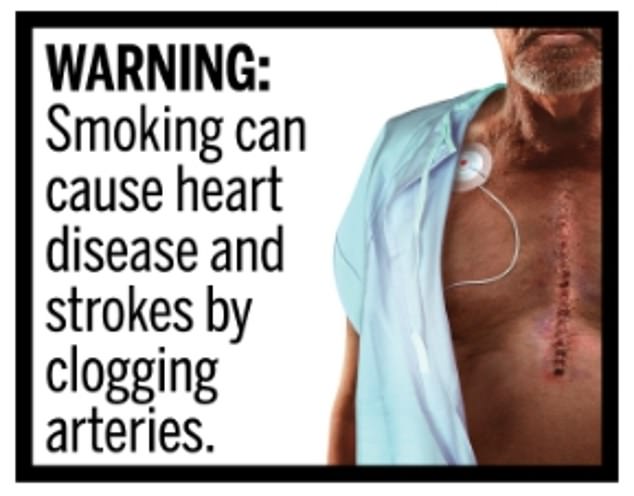- Around 120 other countries require disturbing images to be placed on cigarette boxes
- Cigarette makers argued that the U.S. rule requiring it violates the right to free speech
- READ MORE: US to finally force cigarette stores to display cigarette health warnings
<!–
<!–
<!– <!–
<!–
<!–
<!–
Cigarette cartons sold in the United States could soon be covered with 11 images depicting the harms of smoking, including amputated limbs and neck tumors.
Tobacco companies argued that imposing the warnings – which have been commonplace in the UK and Europe for years – violated their right to free speech because the images, according to the manufacturers, misrepresent the harms of smoking.
But the Fifth Circuit Court of Appeals ruled in favor of the government, saying the images — including amputated toes and rotting lungs — were “both factual and non-controversial.”
The move is a victory for the Biden administration – which is also considering banning menthol-flavored cigarettes – and could see the warnings become mandatory in coming years.

The warnings include a photo of a woman with a large growth protruding from her neck and the caption “WARNING: Smoking causes head and neck cancer.”
Another shows a man’s torso with a long scar from surgery and a warning saying: “Smoking can cause heart disease and stroke by blocking arteries.”
Other images show a baby whose fetal growth has been delayed and whose feet have been toe amputated due to poor blood circulation.
The FDA said these warnings were justified by the government’s interest in promoting a better understanding of the health risks of smoking and reducing confusion and deception.
Tobacco companies countered that the warnings went well beyond the text warnings permitted since 1984, including claims that smoking causes lung cancer and quitting smoking reduces health risks.
Companies fighting this rule include RJ Reynolds, ITG Brands and Liggett Group.
However, in a 3-0 decision, Circuit Judge Jerry Smith said the graphic warnings conveyed facts about the benefits of reducing smoking and were not unconstitutional because they “could provoke emotions” or were linked to ideological or political concerns.


Some studies have indicated that warnings can deter people from smoking, although the evidence is mixed.


Smoking kills about 480,000 Americans each year
Lindsey Powell, representing the FDA, said stirring up emotions “doesn’t push them over the edge to make them controversial… Some facts are upsetting.” »
Tobacco use is responsible for approximately 480,000 deaths each year in the United States.
The ruling overturned a lower court ruling by a Texas judge who sided with tobacco companies.
An FDA rule adopted in 2020 under the Trump administration required warnings about smoking risks to occupy the top 50% of cigarette packages and the top 20% of advertisements. The labels would include 11 graphic images to illustrate the risks of smoking.
Nearly 120 countries around the world have adopted larger graphic warning labels. Some studies in these countries have indicated that the warnings have had some effect in lowering smoking rates and encouraging more smokers to quit.
A 2020 study by researchers at the University of North Carolina found that putting pictures on cigarette warning labels increased the probability that smokers would quit. Yet images do not necessarily change people’s beliefs about the risk of harm.
The study found that showing people warnings such as yellowed teeth and diseased lungs caused immediate emotional reactions, including fear, sadness, guilt and disgust.
They were more likely to think about the health risks associated with smoking. But, despite their effectiveness in motivating smokers to quit, pictorial warnings failed to change viewers’ beliefs about the likelihood or severity of negative health consequences.
At the same time, researchers at the University of California, San Diego, found that smokers given packages bearing images of sick feet, sick children and throat cancer continued to puff about 10 cigarettes a day until ‘one year after receiving them.
Six in ten people admitted to hiding the packets at least some of the time because of the images, an increase of 40% from the start of the study.
